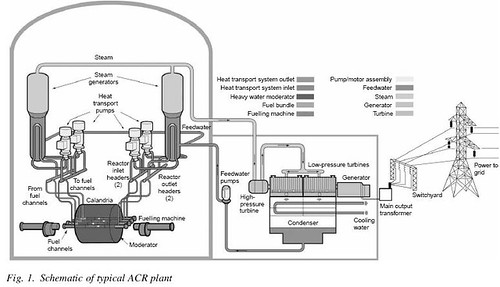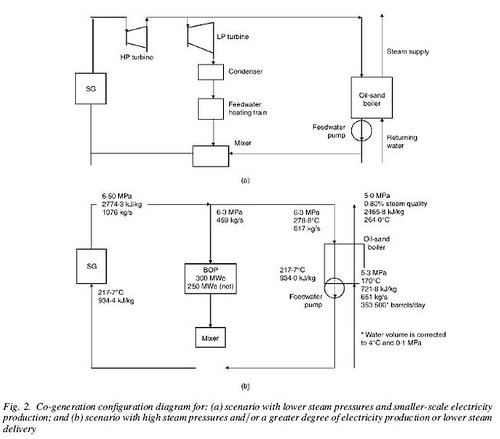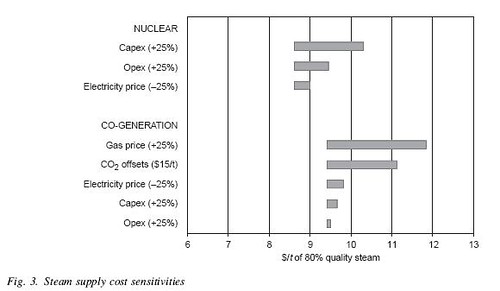In order for nuclear power to replace the burning of natural gas to power the extraction of oil from the oilsands involves about 4.4 GW of nuclear power per million barrels per day of oil extracted (according to Wayne Henuset,director of Energy Alberta Corporation. estimate of a 2.2 GW reactor separating 500,000 bpd). 10 million bpd would take about twenty 2.2 GW twin reactors. A detailed analysis is provided from the Nuclear Energy journal. It was written by Atomic Energy Canada and Canadian Energy Research Institute scientists.
SAGD can recover over 50% of the initial volume of crude bitumen in place.
An average steam/oil ratio of 2-3 is required.
Working from output levels of high quality steam of 62400 m**3/day, a cumulative steam/oil raio of 2.5, operating capacity of 93%, the results was consistent with a 146,000 barrel per day bitumen production.

A typical advanced CANDU reactor

Configuration of a reactor as part of oilsands project
A 728 MWe (gross) nominal electric output ACR-700 design generates 1983 MW (thermal).
The CANDU reactor can be adapted to provide steam of 2-6 MPa.
An ACR700 would provide in one configuration 140MWe (net), 420,000 barrels/day/steam and supply pressure of 2.2 MPa. The production rate of bitumen using this steam would depend on the steam/oil ratios required in the SAGD wells. For steam/oil ratios of 212.4-224 degrees celsius the bitument production rates would be 168,000-210,000 bbl/day. The project would achieve a 10% advantage in steam cost even if natural gas were at USD3.25/mmbtu
The twin 2.2 GWe reactor proposal would generate 507,000 to 634000 bbl/day in a similar configuration with similar assumptions.

Cost Sensivity of the project
“We hope to site it and talk to the communities in the next two months,” he said in an interview on the sidelines of a nuclear industry seminar.
Two further reactors are planned for a later unspecified date.
Canada’s Natural Resources Minister Gary Lunn told Reuters in January that, in theory, he liked the idea of nuclear power for the oil sands.
Henuset said Atomic Energy of Canada Ltd. — the government-owned manufacturer of the Candu — estimated it could build the first reactor in 36 months.
He also said he hoped that nuclear waste from the plant would be stored either on site or in special chambers until it could be reused.
Shell Canada Ltd. Chief Executive Clive Mather told Reuters in January that although he was not ready to buy into the nuclear concept, it could offer a price advantage over time. Shell is a major oil sands operator.
A new Steam Assisted Gravity Drainage (SAGD) process has been developed and proven in Canada during the last decade. It is compatible with the steam conditions from CANDU reactors would release about 0.10 tonnes/barrel for extraction and upgrading of bitumen from much deeper deposits.
Reviewing the short history of oil sands production suggests that, based on current production and past rates of growth, production in 2050 would reach about 1.5 billion barrels/year (4 million bpd). About half would come from in situ projects. Presuming the production rate increases at a higher than historical rate of 5%/year, compounded annually, results in production of 3 billion barrels/year (8 million bpd) by 2050.
A single large dedicated CANDU 9 reactor could supply the steam and electricity to extract and upgrade about 600 million barrels of bitumen over a period of 30 years. The land area from which bitumen would be extracted is about 18 square miles requiring steam distribution and bitumen recovery piping from a centrally located 60,000 barrel/day plant of up to about 3 miles. Smaller reactors would be suitable for smaller production rates with shorter piping distance.
Henuset is quoted as saying that the 2.2 GW twin reactor would separate up to 500,000 barrels of oil a day.
Here is a pdf of a Wayne Henuset speech
The National Energy Board has forecasted that the oil sands production would increase fourfold by 2015, largely using steam assisted gravity drainage. If all the SAGD projects planned were to use natural gas as the fuel in cogeneration systems that would see natural gas demands in the region skyrocket to over 3 billion cubic feet/day by 2015. That’s more natural gas than all the rest of Alberta uses now. 375 million cubic feet/day is replaced by the 2.2GW reactor. USD1.095 billion/year for the 375 million cubic feet/day if natural gas is at $8 per 1000 cubic feet.
[1000 cubic feet of natural gas is equal to 293 kWh. 320 billion kWh per year in 2015. Twenty 2 GW reactors needed to fully replace the natural gas usage]
Putting the brakes on the oil sands development is not the answer. Canada needs the oil sands. Conventional oil and gas reserves are declining. Energy conservations are important and necessary but they won’t eliminate the need for fossil fuels in our economy. In addition, oil sands activities will lead to significant economical impact not only to Albertans but across the nation with substantial increase in gross domestic product, employment generating over $123 billion in tax revenues.
It makes no sense to squander precious and declining reserves of natural gas to make oil in the oil sands. That’s simply like burning gold to make coal. The answer for this is using nuclear power.
The first strategy is using CANDU nuclear electricity generation to extract the oil from the carbonate triangle involving potentially 450 [billion] barrels of bitumen. This is new. The second strategy is generating hydrogen electricity for the upgrading of the bitumen. The third is providing steam supply for the SAGD process in the oil sands; and finally, generating electrical needs for the utility companies in Alberta to keep up with our provinces projected growth.
One ACR1000 reactor would result in an annual displacement of around 500 million tons of CO2 compared to an equivalent gas fired generator accounting to a savings of $100 million, annually, of carbon dioxide cost if it was at $20.
So either you burn natural gas to get at oil from the oilsand OR you use new processes where you burn some of the oilsand to get oil from it OR you make a lot of nuclear reactors. If oil prices stay high and we go past peak oil and the prices go higher then it seems that making the nuclear reactors to extract the most oil for other purposes is the way to go. If all current conventional oil in North America had to be replaced with oil from the oilsands that would be about 24 million bpd. 9 billion barrels per year. if Henuset/AECL/CERI are correct in the 500,000-630,000 bpd estimate then 48 of the 2.2 GW twin reactors would be needed for the SAGD extraction process.
One way of viewing nuclear powered oil sands is to think of it as making a hybrid version of the global energy system.

Brian Wang is a Futurist Thought Leader and a popular Science blogger with 1 million readers per month. His blog Nextbigfuture.com is ranked #1 Science News Blog. It covers many disruptive technology and trends including Space, Robotics, Artificial Intelligence, Medicine, Anti-aging Biotechnology, and Nanotechnology.
Known for identifying cutting edge technologies, he is currently a Co-Founder of a startup and fundraiser for high potential early-stage companies. He is the Head of Research for Allocations for deep technology investments and an Angel Investor at Space Angels.
A frequent speaker at corporations, he has been a TEDx speaker, a Singularity University speaker and guest at numerous interviews for radio and podcasts. He is open to public speaking and advising engagements.






Comments are closed.